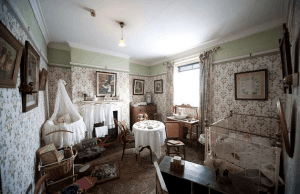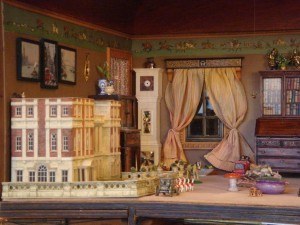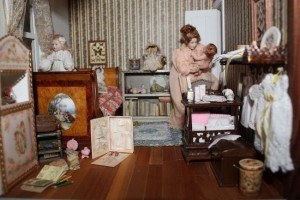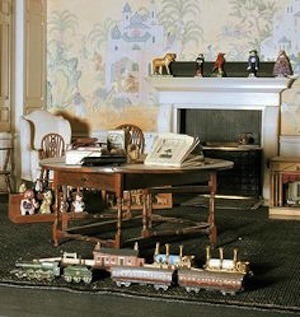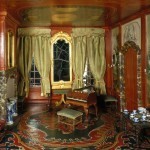
Miss Miles’ Dolls House Day Nursery video by Olleana Ottini
Nurseries – Why Pink or Blue?
It seems to be a hard and fast rule today that pink is for girls, boys are blue. It wasn’t always this way. One of the best things about dollhouse miniatures is that they reflect the lives of real people that might have lived in them over the centuries. Nursery color schemes were all over the place. But today, we seem to be stuck with a pink/blue stereotype. Has there been some biological gender change in babies, or is it a cultural choice? And what does a dollhouse enthusiast do with the answer?
Academic Research
Decades of research by University of Maryland historian Jo Paoletti suggests that up until the 1950s, chaos reigned when it came to the colors of baby paraphernalia.
“There was no gender-color symbolism that held true everywhere,” Paoletti told Life’s Little Mysteries. “Because the pink-for-a-girl, blue-for-a-boy social norms only set in during the 20th century in the United States, they cannot possibly stem from any evolved differences between boys’ and girls’ favorite colors.”
Marketing Failure
Philip Cohen, also a sociologist at the University of Maryland, thinks they are the outcome of a marketing ploy that didn’t work the first time around. “There was a 1927 chart in Time Magazine where department stores in various cities were contacted and asked what colors they used for boys and girls. And it was all over the map.”
Jo Paoletti added. “It wasn’t until after the Second World War that the modern convention (pink for girls, blue for boys) started to dominate, and even so, it didn’t “gel” until the 1950s. This happened during a time when mass marketing was appearing,”
Philip Cohen told Life’s Little Mysteries. “Being ‘gender normal’ is very important [in our society], and as a marketing technique, if retailers can convince you that being gender normal means you need to buy a certain product ― cosmetics, plastic surgery, blue or pink clothing, etc. ― it just makes sense from a production or mass marketing perspective.”
Marketing Success
There it is. Blame it on Don Draper and the rest of the Mad Men!
Well, maybe not. Paoletti argues that the pink or blue stereotype we use today “may reflect the influence of French fashion. Traditional French culture paired pink with girls and blue with boys (while Belgian and the Catholic German culture used the opposite), and because France set the fashion in the 20th century, their tradition held sway.”
Okay. There’s the answer! It’s a giant conspiracy between the chain-smoking-three-Martini-lunch-bunch on Madison Avenue and the Haut Couture crowd on the Rue-de-Something. That’s where the Pink/Blue Rule originated.
But still, what does the dollhouse enthusiast do with this information?
An Opposing View
Marco Del Guidice, a sociologist at the University of Turin in Italy, says [that in] a simple search of all the books published in the United States between 1880 and 1980, pink was associated with girls and blue with boys during that entire time. Using the program Google Ngram, he searched for the phrases “blue for boys,” “pink for girls,” “blue for girls, “pink for boys,” as well as the singular versions “blue for a boy,” and so on. The rules some of us abide by today appeared in books from 1880 onward, becoming more common over time, but the opposite rules didn’t turn up in the book search at all.
An Urban Legend?
“Pink seems to have been a feminine color at least since the late 19th century,” Del Guidice wrote in an email. “In summary, when inspected closely, the reversal in pink-blue gender coding shows many warning signs of a scientific ‘urban legend,’ an urban legend that somehow managed to infiltrate the peer-reviewed literature.” [Our Favorite Urban Legends Debunked]
Cohen adds that despite Del Guidice’s book-search results, all other evidence indicates that, today, we differentiate children by gender much more than we did 150 years ago when babies of either gender were typically outfitted in white dresses.
So?
Again I ask, “What’s a dollhouse miniature enthusiast to do with this conflicting information?”
I guess the answer is: Any darn thing you want.
Susan Downing, with Patrick Owens
_________________________________________________________________________
I invite you to visit my Etsy Shop where I offer many accessories and pieces of furniture in 1:12 scale.


